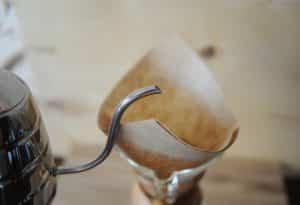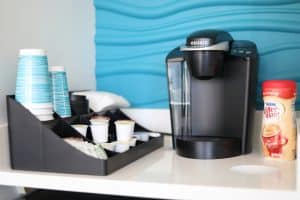
Can you reuse Chemex filters? We have the answer!
The Chemex coffee maker is one of the great classic pour-over coffee makers. You can make fantastic coffee with one, and as a bonus, it
Pour over coffee is a great way to get back control. You can determine what your coffee tastes like. It takes some practice, though, and this is what might scare off a beginner. But, it is actually quite easy to learn, and choosing the right pour over cone can be a great help in overcoming the beginner struggles you might face.
In this article, I will discuss the different characteristics of pour over coffee and the most popular pour over coffee makers. I will also show you which one I think is best for a beginner.
But, if you are pressed for time, let me just tell you now:
The best pour over coffee maker for beginners is the Kalita Wave. Although it is not as flexible as, for instance, the Hario V60 or the Chemex coffee maker, it is very forgiving. It will provide you with a beautifully crisp and flavorful cup of pour over coffee, no matter how bad your pouring technique is.

Now, let’s dive in a bit deeper and start with the question:
Pour over coffee is a coffee-making method that is entirely hands-on. As the name suggests, it involves pouring hot water on a bed of ground coffee. The ground coffee sits in a cone-shaped container with a paper filter. Water is added gradually, in a circular motion, and runs through the ground coffee slowly.
Compared to the push-of-a-button coffee you get from a Keurig or a Nespresso, it is a quite involved coffee-making method. It takes time, attention, and a bit of skill to produce a good cup. But, according to specialty coffee lovers, it is completely worth it.
Making coffee with a pour over method has become increasingly popular in North America and Europe in the last decade. But, it has been quite common in Japan where people tend to take making coffee almost as seriously as making tea.
Pour over coffee is a brew method that, if applied properly, allows the full potential of the coffee bean to land in your cup. The slow, measured pace at which the water poured allows every flavor compound in the coffee bean to extract. This results in a cup of coffee that cannot be compared to the quick and easy methods used with popular coffee machines like Keurig and Nespresso.
Most coffee lovers agree that pour over coffee is superior, but that’s a matter of taste. To be fair, a lot of pour over aficionados are as much in love with the process of making pour-over coffee as they are with the result.
And there is something to say for that point of view. The pour over brew method allows you to control every aspect of the coffee-making process. How much coffee you use, the grind size, the amount and the temperature of the water, and the rate at which the water is added to the ground coffee.
These aspects all influence the taste of the end result. And this is precisely what can make pour over coffee seem a daunting endeavor for beginners. But fear not, it is a process anyone can easily learn.
And having the right gear helps tremendously.
To make pour over coffee, there are a couple of pieces of gear that are essential (or at least very helpful to have on hand):
This is the piece of equipment that holds the filter and the ground coffee and where the water is poured on.
You need to measure the amount of coffee you put in the filter, but even more importantly, you need to measure the amount of water that is poured on. To be fair, a kitchen scale isn’t absolutely critical. You could measure the amount of coffee with a coffee scoop and the amount of water with a measuring cup before heating it. But, it will make your life a lot easier, and you will be able to be much more consistent. It is easy to use exactly the same amount of coffee and exactly the same amount of water when you use a kitchen scale. With a coffee scoop and a measuring cup, this is nearly impossible.
You need a way to boil water. And you can use any kettle (either stovetop or electric) or even a saucepan. Still, if you really want to up your game, a gooseneck kettle is the way to go. A gooseneck kettle has a long thin spout. This allows you to perfectly control the water flow.
If you are interested in finding out more about gooseneck kettles, please consider
checking our article on the best gooseneck kettles.
You need ground coffee to make coffee, that’s a given. Sure, you could buy pre-ground coffee, but you would be missing out. Grinding your coffee beans right before you use them is the best thing you can do to improve the quality of your coffee. Nothing beats freshly ground coffee.
Besides freshness, grinding your own coffee beans also gives you a lot more control. The grind size (finer or coarser) determines the level of extraction and the rate at which the water runs through the bed of ground coffee.
The finer the grind, the more surface level and, therefore, the more extraction of flavor you get. The coarser the grind, the faster the water runs through the coffee, which gives it less time to extract flavor from the coffee.
The interplay between surface level and time in contact with water is what determines the extraction level. Making coffee is all about optimizing the balance between the amount of coffee and the time it is in contact with the water.
Too much time in contact with water (with a finer grind size) leads to over-extraction, which leads to off-flavors like bitterness. Too little time in contact with water leads to under-extraction, which tastes like nothing.
This might seem like a lot to take in, but just all you need to remember is: grind size matters, and a grinder allows you to control grind size. So get a grinder.
If you are interested in finding out more coffee bean grinders, please consider checking our articles on the best manual coffee grinders, and the best automatic coffee grinders.
another aspect we mentioned earlier that has an impact on the flavor of the coffee you make is water temperature. A common mistake is to make coffee with water that comes right of the boil.
Water that comes right of the boil is way to hot to properly extract the delicate flavor compounds in the coffee bean. The optimal water temperature for brewing coffee is set between 195 and 205 degrees Fahrenheit (or between 90 and 96 degrees Celsius) by the National Coffee Association. Source
A simple thermometer helps you dial in the optimal water temperature.
This might seem like a lot of equipment for a simple cup of coffee. But you should realize that the price of the individual items is relatively low. The total costs for a basic pour over set up about the same as for an entry-level single-serve coffee maker by Keurig or Nespresso!
Pour-over coffee is one of those things that is easy to learn but difficult to master. It has a lot of moving parts. Grind size, water temperature, coffee to water ratio, how much water to pour on at each pour, how long to wait between each pour, and on… and on…
But rest assured, if you follow the proper steps, you will make great pour over coffee in no time. There will probably be a lot of room for improvement at first, but you will get better quickly.
And the learning process is a good thing. Besides learning to master the different aspects of making good pour over coffee, you will also develop your taste. You will figure out what you like and what you don’t like. After all, what makes a coffee ‘good’ is slightly different for each of us. And by learning what happens when you make subtle changes, you will be able to figure out your ideal pour over recipe.
But you need a place to start.
We have written a pour over brew guide, which you should consider reading. It gives you a solid base to start from. Check it here.
A critical difference between pour over coffee and immersion coffee brewing is the time the ground coffee is in contact with water. With pour-over coffee, the time in contact with water is relatively short. You pour the water on the coffee, and it runs through in a matter of seconds, depending on the grind size.
With immersion brewing, you add water to the ground coffee, let it sit, and then you separate the coffee from the grounds by some sort of filtration method. Immersion brewing results in a full-bodied, ’round’-flavored, a cup of coffee. Compared to a pour over coffee, it is less crisp and clean tasting. Some even say their taste is a bit muddy due to the tiny coffee particles suspended in the liquid.
The most common immersion brewer is the French Press. With the French Press, you typically let the ground coffee beans sit in hot water for about 4 minutes. After that, you ‘plunge’ to separate the coffee from the grounds.
Two other immersion brewers are the Aeropress and the Clever Dripper. These coffee makers differ from the French Press because they both use a paper filter and shorter brew times. This results in a cleaner, more crisp cup of coffee while retaining the characteristic full-bodied flavor of an immersion brew.
The Clever Dripper is, in my opinion, more of a hybrid between an immersion brewer and a pour over coffee maker. While the ground coffee is steeped in hot water (making it an immersion brewer), the use of the conical shape and especially the paper filter, makes the coffee from the Clever Dripper taste somewhat more like a pour-over coffee.
For beginners, an immersion brewer is far easier to use. There is no need to time the different pours and no deciding when to add more water or when to wait for it to drain a bit more.
But the question we are trying to answer here is which pour over coffee maker is best for beginners. So, immersion brewers are not an option.
Or are they?
The short answer is: No. The Clever Dripper is an immersion coffee maker, not a pour over coffee maker.
But, if you are new to manual brew methods and specialty coffee in general, the Clever Dripper just might be the best place to start your journey.
The Clever Dripper has the ease of use of an immersion coffee maker. All you do is: measure out your coffee and water, dump it all in the filter, wait, and let it drain. The result is a clean, crisp, and full-bodied coffee that brings out the best in those expensive artisanal coffee beans you bought.
On top of that, it is very affordable! Combined with a good set of kitchen scales, a thermometer, and good quality (but affordable) manual coffee bean grinder, you are all set for about $100.
So, in my opinion, the Clever Dripper is the ultimate coffee maker for people who are just getting into making specialty coffee at home.
Before we decide which pour over coffee maker is the best for beginners, let’s take a look at what’s on offer. And there is a lot to choose from. For now, we focus on the most popular pour over coffee makers. Frankly, these are also simply the best pour over coffee makers
The Hario V60 is one of the specialty coffee world icons and can be found in coffee bars around the world. The Hario V60 is made by Japanse glassware manufacturer Hario, which has been in business since 1921. They know their glassware (and their ceramics) and have a name to reflect that. Hario is Japanese for ‘king of glass.’
Take that, Mr. Coffee.
V60 stands simply for the cone-shape or v-shaped form factor and the degree at which the walls stand relative to the base, 60 degrees.
The Chemex is also an icon but originates in Europe and the United States. It was designed by German chemist Peter Schlumbohm. Production started in the early 1940s in the United States, where Schlumbohm and his American partners.
The Chemex has become such an icon of wartime design that it landed a place in the Museum of Modern Art and can be seen in many popular movies and series (e.g., James Bond – From Russia With Love, Mad Men).
We have compared these two icons of pour over coffee in their very own stand-off. Click here to check out the article.
The Kalita Wave is another pour over cone from Japan, like the Hario V60. But it looks very different. Less high, the walls are more upright, and a flat bottom. And what about the filters? They look like big muffin cups.
Every element of the Kalita Wave serves a purpose. From the ‘wavy’ sides (in some models) to muffin cup-shaped filters, and the flat, three-holed bottom. The Kalita Wave aims for stability in the water flow for excellent repeatability.
While not as popular in the west as the Hario V60 and the Chemex, the Kalita has been gaining a following in recent years, and rightly so.
While all this well-designed specialty coffee gear is all very nice, we cannot skip the generic plastic pour over cone.
Everyone has seen them.
Your grandma probably used them to make coffee.
Okay, she might have had a ceramic or metal one, but still. No museum has one, and there is no exotic eastern heritage.
But it got the job done. And it might still. You can find them everywhere. Except on Amazon for some reason. Sure, the $9.99 one you can find, but that’s too expensive. I am talking about the $2 ones.
That’s the one you need.
But for real, what is the best pour over coffee maker for beginners? I am just gonna say it. It is not the most popular one (Hario V60), and not the one that is most prized for its design (Chemex). The absolute best pour over coffee maker for beginners is the Kalita Wave.
Why?
Let me explain.
The Kalita Wave is designed with stability and repeatability in mind. The waved sides and muffin cup filters all promoted airflow that helps with the water running through the bed of coffee. The same goes for the flat bottom with the three holes. These also help with a steady flow of the water you pour on.
It matters less how you pour the water on. Sure, pouring in the water little by little results in a heavier, more full-bodied cup of coffee. But pouring the water on in one continuous pour (as is intended) results in a consistently good cup of coffee.
There are some downsides that you need to consider though. The stability of the Kalita Wave also means that there is less flexibility. Less room to experiment by adjusting your pouring technique. The (amount and variety of) coffee, the grind, and the water temperature are your variables.
This also means the Wave is less fussy, and there is less of a learning curve. And that is precisely why it is excellent for beginners.
MonsieurCoffee.com is a participant in the Amazon Services LLC Associates Program, an affiliate advertising program designed to provide a means for sites to earn advertising fees by advertising and linking to Amazon.com. We earn small commissions on purchase made through links on this site, at no extra costs to you.

The Chemex coffee maker is one of the great classic pour-over coffee makers. You can make fantastic coffee with one, and as a bonus, it

When the snow melts, the trees grow new leaves, and shorts or skirts and t-shirts start to dominate our wardrobe, you know: summer is here,

So you want to take your morning coffee to go. You don’t have time to drink it at home before heading out to work. Or,

Coffee is a necessity for me in the morning. And like many Americans, my first cup of the day usually comes from a Keurig coffee